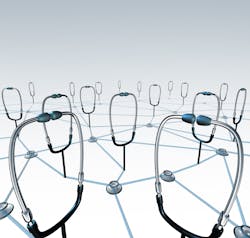The COVID-19 outbreak has put great burden on the global healthcare ecosystem, and the perilous speed at which the virus can spread has only placed greater emphasis on the need for providers to have real-time, accurate data at the point of care.
Historically, health information exchanges (HIEs) have played a key role in disaster relief efforts. For instance, when a natural disaster, such as a hurricane, strikes down, individuals often have to evacuate the places where they normally receive care and where their healthcare records are housed. In these situations, having an IT infrastructure that allows a provider to look up important data on a visiting patient is crucial for care delivery.
The COVID-19 crisis has presented a different type of challenge than man-made disasters, but nonetheless, HIEs across the U.S. have been ramping up efforts to play a part in helping their members respond to the public health emergency. Healthcare Innovation reported earlier this spring on a number of data-exchange networks around the country that are stepping up to play a part in sharing information and coordinating care in the face of the COVID-19 crisis.
Indeed, HIEs, just by their nature, gather data from many different locations such as hospitals, physician practices, labs and community-based organizations. For COVID-19 in particular, the data that comes into HIEs is in near real-time, and includes information on patients’ diagnoses, such as recording a positive COVID lab test, if a patient was admitted to a hospital as either an inpatient or to the ER, if he or she has any underlying conditions, and how long the length-of-stay was, explains Laura McCrary, president and CEO at KONZA, a Kansas-headquartered nationwide health information network that works directly with several state medical societies to support their HIE efforts.
Throughout the pandemic, KONZA has been working closely with University of Kansas Medical Center to provide key patient data to both that hospital and some 125 others across the state that the health information network has direct connections with. “We provide [these organizations] with de-identified information—[data] on the number of positive COVID patients that have been admitted into the hospital, or into the ER, and how long their length-of-stays were. The opportunity to [leverage] HIEs has been highlighted very well with this particular disease outbreak. They are [quite] helpful when you have a national crisis and you want to get as much data as quickly as possible around specific disease conditions,” McCrary contends.
What’s more, KONZA also has a proprietary alerting platform ,and has built out a specific view that its end-user customers can click on to see other patients who have been admitted to or discharged from the hospital, and which of those individuals had a diagnosis or suspicion of COVID, explains McCrary.
“We have a special tab we have built out on our alerting dashboards in order to provide that [information] to a practice or to a specialty care organization that tracks their own patients for hospital admissions and discharges. Alerting is one of those things that’s particularly valuable that HIEs provide, as we have these connections to hospitals across our state, and we can provide an alert to physicians, even if their patients have been hospitalized in a [facility] 40 or 50 miles away from their hometown, but have been transported to a hospital that has more capacity,” she adds.
Equally important, McCrary notes, is the ability to provide that receiving doctor or hospitalist a longitudinal medical record with complete information on the patient as it relates to his or her previous medical care, and potentially any medical care that was received before being transported. She credits the organization’s technology vendor Diameter Health with this element, as it takes all the information KONZA receives from various locations and puts it together in a single document that is de-duplicated and normalized. This makes it “quick and easy for a physician or nurse to go through that document, scan it, and see all the relevant information around the patient’s medications, previous diagnoses, and allergies. That’s so important for the receiving doctor to have all that data to be able to make good decisions,” says McCrary.
Overall, KONZA has more than 10,000 members on its network, though it doesn’t aggregate information into its dashboard and alerts for all of those organizations. However, it does make its data available at the point of care for the purposes of treatment for each one of those members, McCrary explains.
KONZA also recently announced it is providing free access to its network throughout the crisis, so “anyone who has a treatment relationship with a patient can sign up to get free access to the KONZA exchange no matter where you are located,” she says. “We are not geographically dependent. We work closely with the eHealth Exchange, and continue to onboard some of the largest health systems in the U.S.,” McCrary adds, specifically singling out certain hospitals who have seen recent surges in COVID patients, such as Yale New Haven Hospital in Connecticut, Grady Health in Atlanta, and Ochsner Health in Louisiana. “As a national network, we have the ability to provide data even if patients are moving across the country. It’s one of the real advantages to having a nationwide HIE,” she says.
Elsewhere across the U.S., data exchange efforts to aid providers dealing with either confirmed or suspected COVID-19 patients are also ramping up. In Virginia, for example, ConnectVirginia HIE, the statewide network for the Commonwealth of Virginia, has been working closely with the Virginia Department of Health to get information into the HIE on positive and negative COVID lab results.
The data filters through the HIE’s vendor, Collective Medical, and provides timely information such as when a patient is admitted to the hospital, thus allowing the network to set up an ADT (admission/discharge/transfer) feed. This could then be used to send information back to the health department, which then has a greater ability to coordinate care and identify who needs to be isolated, explains Michael Lundberg, executive director of Virginia Health Information, which runs the ConnectVirginia HIE.
He further notes that the health department has traditionally had trouble tracing patients and following up with them, as their demographic data can easily get muddled, so the HIE helps in this area as well by collecting that data when the patient is admitted to a hospital. Every health system in the state and 120 EDs are connected to the network, says Lundberg.
Both Lundberg and McCrary also point to the importance in data accuracy, which was previously difficult as there was no official ICD-10 code for COVID-19 before April 1. Prior to that time, organizations would use a series of other codes that were related to the suspicion of or possible exposure to COVID-19. KONZA and its technology partner Diameter Health worked hand-in-hand to educate the network’s leaders on the different diagnosis codes, lab codes, and procedure codes associated with the condition, so they can in turn relay that information to help their customers, McCrary reports.
“There is a story for each one of these patients and the data tells the story,” she adds. “But if it’s not entered correctly or the codes are wrong, or the EHR vendor doesn’t transport a full set of data, then patients’ lives can be put at risk because we didn’t give the correct information to the doctor at the point of care.”


